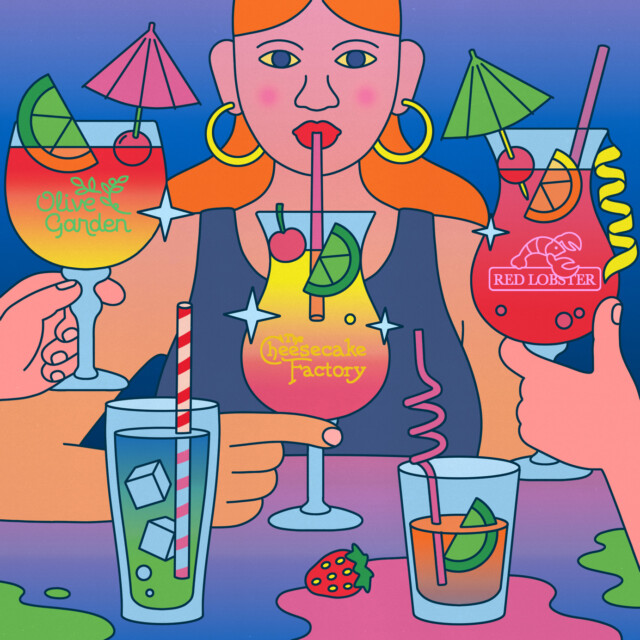After placing a footed glass filled with frothy, pink liquid atop a thick marble bar, the bartender gently pours something glittery and purple over my drink from a tiny pitcher. Like sorcery, the shimmering liquid — made from butterfly pea flower tea — cascades down in swirling wisps of mauve and indigo like a Bali sunset. This isn’t a trendy craft cocktail bar with mustachioed mixologists and $30 cocktails. I’m having a drink at the Red Lobster in Times Square. The cocktail, called “Under the Purple Sea,” looks much better than it tastes — somewhere between an alcohol-spiked Pacific Cooler Capri Sun and Sour Patch Kids watermelon candy. Luckily, I came in with low expectations, so the flamboyant presentation more than made up for the drink’s uninspiring flavor.
Chain restaurant bars aren’t exactly known for their mixological prowess, but as consumers become more cocktail savvy, some corporate restaurant brands have been quietly raising their game. Late last year, I had an exemplary Espresso Martini at a Cheesecake Factory in Queens, which came in a voluptuous 8-ounce Martini glass with a head of foam like a freshly drawn Guinness. After canvassing several popular corporate chains like Olive Garden, Texas Roadhouse, and Bubba Gump Shrimp Co. over the past several months, I can say with confidence that, while some bars show signs of improvement, chain restaurant mixology remains a mixed bag.
The Glory Days of TGI Fridays
Despite the ignominious state of many chain restaurant bar programs, it would be irresponsible to ignore the foundational role that the original TGI Fridays, founded in New York City by Alan Stillman in 1965, played in the cocktail revolution. “In the early days, TGI Fridays was an incubator of bartending skill and discipline during a period when bartending was considered a dead end,” wrote Robert Simonson in his book, “A Proper Drink: The Untold Story of How a Band of Bartenders Saved The Civilized Drinking World.” To become a bartender at Fridays back then, employees had to commit over 400 cocktail recipes to memory and pass a comprehensive written exam. Flair bartending, popularized by the 1988 movie “Cocktail,” also emanated from behind the bars of TGI Fridays.
“When I worked at TGI Fridays in London, we did six weeks of one-on-one training,” says Philip Duff, the founder of Old Duff Genever who worked as a bartender and staff trainer in various locations of TGI Fridays in the British capital between 1992 and 1994. He credits the company’s meticulous training regimen with helping to kickstart the cocktail renaissance in the U.K. and cultivating a generation of well-trained bartenders. The structure that these systems provided also helped shape his career as a consultant for bars and liquor brands. However, Duff readily admits that the chain is no longer a reliable source for craft cocktails. “Fridays used to be the cocktail bar,” Duff says. “Now it’s following trends instead of setting them.”
A recent visit to a Fridays near Madison Square Garden in Manhattan proved him right. There, I sampled a new summer cocktail called the “Lavender Fields Lemon Drop Martini.” It’s a basic sour recipe, made with Skyy Vodka, lemon juice, and lavender syrup. The cocktail itself wasn’t nearly as satisfying as my banter with the quick-witted bartender, who seemed like she’d been shaking drinks for as long as I’ve been alive. The lavender flavor was overpowering, like a blast of Glade air freshener, but the drink was palatable and neatly presented in a coupe with a twist of lemon.
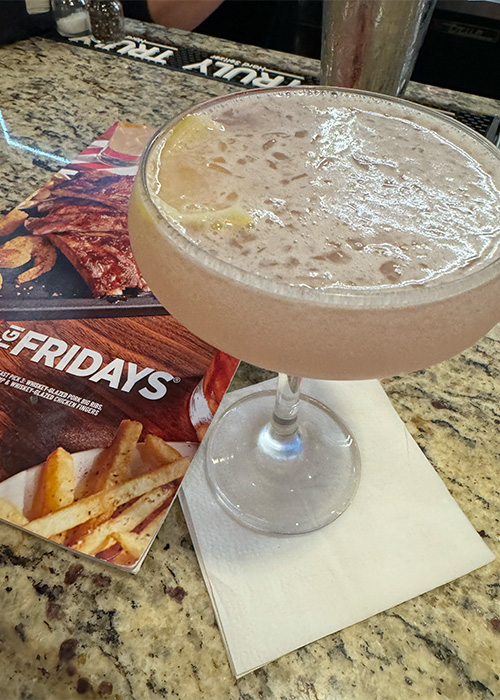
“Every cocktail at TGI Fridays is too sweet,” says Izzy Tulloch, the head bartender at Milady’s in New York’s SoHo neighborhood. “Ask for a plate of lemon or lime wedges, and you can pretty much balance anything that hits your table.” Tulloch admits that most chain restaurant bars today are mid, but she still believes there’s a time and place to enjoy them. “Applebee’s has dollar Margaritas sometimes. You don’t need to know more than that,” she says. “They’re bad, but they’re a dollar, and you can get half-priced apps and have yourself a time.”
Chain Cocktails Hit Different
Some bartenders have a soft spot for chain restaurants because they’ve had firsthand experience working in them. “I worked in a Chili’s in high school,” says Sarah Morrissey, the bar manager of the recently reopened Le Veau d’Or on New York’s Upper East Side. “I used to watch the daytime bartender make vats of Margarita mix from powder and water. For some reason, I still think the Presidente Margarita is incredible. It’s the ‘fajita’ of their cocktail list.”
To achieve scale, chain restaurant bars need to be streamlined for speed and consistency. Signature cocktails are designed to taste the same across hundreds of locations, so ingredients are often prefabricated and laced with sugar and preservatives. Many chains also limit their cocktail menus to familiar classics like Cosmopolitans and Margaritas because customer loyalty is earned through predictability, not inventiveness.
But as bar consumers become more educated about cocktails and spirits, chain restaurants are showing signs of leveling up their beverage programs. While some still feel stuck in the ‘90s, others are evolving to meet the moment. I doubt that Cheesecake Factory would’ve offered a drink called the Aperol Spritz Martini (the classic Venetian aperitivo in Martini form) on its menu 10 years ago, as it does today. Trendier cocktails like the Paloma and Mojito have also been popping up on more chain restaurant menus recently.
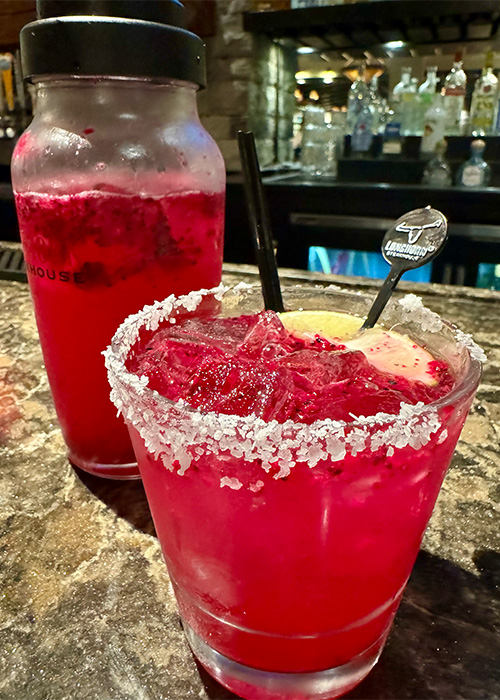
When I ordered the Patrón Dragon Fruit Margarita at Longhorn Steakhouse (Olive Garden’s carnivorous sibling), the cheerful bartender presented me with a branded cocktail shaker the size of a Stanley tumbler filled to the brim with pulpy, magenta liquid. After replenishing my salt-rimmed glass several times, I would estimate that the shaker contained the equivalent of three normal-sized cocktails. Even if the Patrón tequila was indiscernible in the drink, the three-for-one value proposition (only $13.49) more than compensated.
Strong Drinks Mixed With Nostalgia
Blue drinks have also become a staple of modern chain-restaurant bars. At Texas Roadhouse, I accepted the bartender’s invitation to add an “island kicker” to the Kenny’s Cooler. The test-tube-like vile of coconut rum and peach schnapps comes propped upright in the cocktail, whose color is uncomfortably close to window washer fluid. The entire drink menu at Texas Roadhouse seems designed to coax guests into the reckless decision to add kickers to already weapons-grade cocktails. Red Lobster also offers Blue Dream Sangria with St-Germain, blue curaçao, Moscato, white cranberry juice, and lemon-lime soda. I didn’t have the courage to order one, but the gentleman down the bar from me seemed to be enjoying his. If I hadn’t seen the menu, I might have easily mistaken his drink for Gatorade Glacier Freeze.
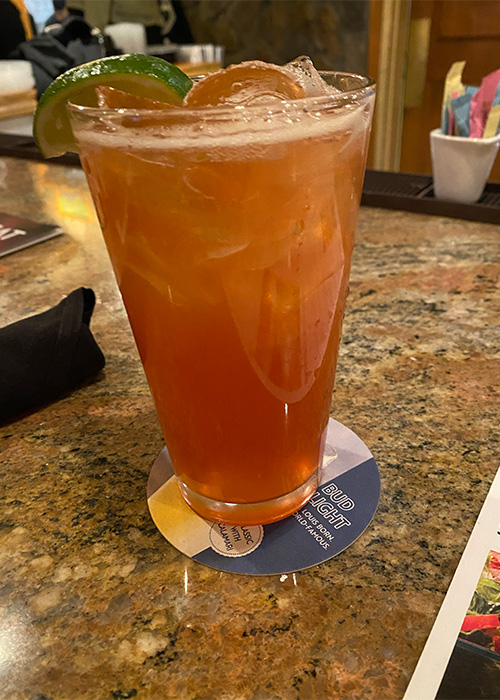
Drink-wise, Olive Garden is curiously uncomfortable with its own allegedly Italian heritage. Despite the wealth of iconic national cocktails, like the Negroni and Aperol Spritz, Olive Garden eschews Italian classics. Instead, it offers fruity chain-washed concoctions like the Italian Rum Punch, which is about as Italian as something you’d be served in the Italy pavilion at Epcot Center. The cloying cocktail comes in a pint glass and tastes like the bartender drained 15 unfrozen freeze pops into a glass of ice with a few ounces of bottom-shelf rum. “Olive Garden is for Martinis,” says Tulloch. “Don’t get crazy, just a Dirty Martini with gin or vodka.”
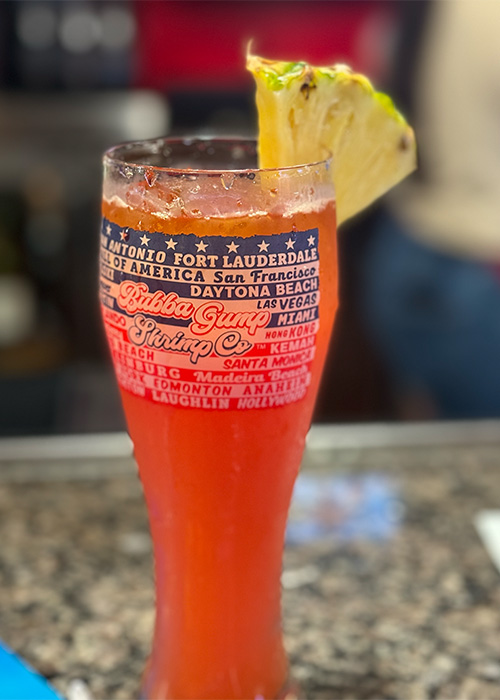
If you fancy something tropical, you’d be better off with the Rum Forest Rum from Bubba Gump Shrimp Co., which is served in a collectible pilsner glass (included with your purchase), and made with a blend of reputable rums like Myers and Don Q. The addition of grenadine and pineapple juice evokes the flavors of a cheap plastic cup Mai Tai at a touristy beachside bar in Waikiki. The Castaway Cocktail at Outback Steakhouse is also respectable, even if its recipe (Cruzan Passion Fruit Rum, Malibu Coconut Rum, Absolut Mandarin, blood orange sour, and pineapple) is a shameless vehicle for product placement. The drink tasted vaguely like SweeTarts dissolved in coconut milk, but I still preferred it to the Olive Garden version.
As much as some chain restaurant bars have improved, their bar programs are still held back by bureaucratic systems that prize efficiency over quality. Duff isn’t optimistic that the glory days of TGI Fridays will ever be restored. “The potato skins still taste the same. The sweet-and-sour mix is fine,” he says. “But people’s tastes have changed. A cocktail that was acceptable in 1995 is not acceptable today.”
Aside from nostalgia, the primary appeal of chain restaurant bars remains consistency. Bartenders like Tulloch still see value in the chain restaurant bar experience, as long as people go into it with the right mindset. “Don’t take yourself or the restaurant too seriously,” she says, “and it might be the best night of your life.”
